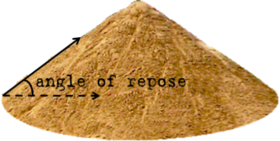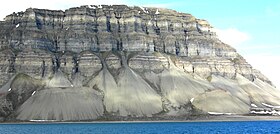Angle Of Repose Dry Sand

The angle of placidity, or disquisitional bending of repose,[1] of a granular material is the steepest angle of descent or dip relative to the horizontal airplane to which a cloth tin can be piled without slumping. At this bending, the material on the slope face is on the verge of sliding. The bending of serenity can range from 0° to 90°. The morphology of the material affects the angle of repose; shine, rounded sand grains cannot be piled as steeply as can rough, interlocking sands. The angle of repose can also be affected past additions of solvents. If a small amount of water is able to span the gaps between particles, electrostatic attraction of the h2o to mineral surfaces will increase the angle of repose, and related quantities such as the soil strength.
When bulk granular materials are poured onto a horizontal surface, a conical pile will form. The internal angle between the surface of the pile and the horizontal surface is known as the angle of serenity and is related to the density, surface expanse and shapes of the particles, and the coefficient of friction of the material. Material with a depression angle of repose forms flatter piles than cloth with a high bending of repose.
The term has a related usage in mechanics, where it refers to the maximum angle at which an object can residuum on an inclined airplane without sliding down. This angle is equal to the arctangent of the coefficient of static friction μ s between the surfaces.
Applications of theory [edit]

The angle of repose is sometimes used in the blueprint of equipment for the processing of particulate solids. For example, information technology may be used to design an advisable hopper or silo to store the material, or to size a conveyor belt for transporting the material. It can also be used in determining whether or not a gradient (of a stockpile, or uncompacted gravel banking concern, for example) will likely collapse; the talus slope is derived from angle of quiet and represents the steepest slope a pile of granular material will have. This angle of repose is also crucial in correctly calculating stability in vessels.
It is also commonly used by mountaineers as a factor in analysing avalanche danger in mountainous areas.[ commendation needed ]
Measurement [edit]
At that place are numerous methods for measuring angle of repose and each produces slightly different results. Results are as well sensitive to the exact methodology of the experimenter. As a result, data from different labs are not e'er comparable. One method is the triaxial shear test, another is the direct shear test.
If the coefficient of static friction is known of a material, then a skilful approximation of the angle of repose can exist made with the following function. This function is somewhat accurate for piles where individual objects in the pile are minuscule and piled in random order.[2]
where, μ s is the coefficient of static friction, and is the bending of repose.
Methods in determining the angle of serenity [edit]
The measured angle of repose may vary with the method used.
Tilting box method [edit]
This method is advisable for fine-grained, not-cohesive materials with private particle size less than 10 mm. The material is placed within a box with a transparent side to observe the granular test material. It should initially be level and parallel to the base of the box. The box is slowly tilted until the fabric begins to slide in majority, and the bending of the tilt is measured.
Fixed funnel method [edit]
The material is poured through a funnel to course a cone. The tip of the funnel should be held close to the growing cone and slowly raised as the pile grows, to minimize the impact of falling particles. Stop pouring the material when the pile reaches a predetermined peak or the base a predetermined width. Rather than endeavour to measure the angle of the resulting cone directly, carve up the peak by half the width of the base of operations of the cone. The inverse tangent of this ratio is the bending of quiet.
Revolving cylinder method [edit]
The fabric is placed within a cylinder with at least one transparent finish. The cylinder is rotated at a fixed speed and the observer watches the fabric moving inside the rotating cylinder. The result is similar to watching dress tumble over one some other in a slowly rotating dress dryer. The granular material will assume a certain angle as it flows inside the rotating cylinder. This method is recommended for obtaining the dynamic angle of repose, and may vary from the static angle of repose measured by other methods.
Of various materials [edit]

This pile of corn has a low bending of tranquillity
Hither is a list of various materials and their angle of placidity.[3] All measurements are approximated.
| Textile (condition) | Angle of Repose (degrees) |
|---|---|
| Ashes | 40° |
| Asphalt (crushed) | 30–45° |
| Bark (wood pass up) | 45° |
| Bran | 30–45° |
| Chalk | 45° |
| Clay (dry out lump) | 25–40° |
| Clay (wet excavated) | fifteen° |
| Clover seed | 28° |
| Kokosnoot (shredded) | 45° |
| Coffee bean (fresh) | 35–45° |
| Globe | 30–45° |
| Flour (corn) | 30–40° |
| Flour (wheat) | 45° |
| Granite | 35–40° |
| Gravel (crushed stone) | 45° |
| Gravel (natural w/ sand) | 25–30° |
| Malt | 30–45° |
| Sand (dry) | 34° |
| Sand (h2o filled) | fifteen–30° |
| Sand (wet) | 45° |
| Snow | 38°[iv] |
| Urea (Granular) | 27° [5] |
| Wheat | 27° |
With different supports [edit]
Dissimilar supports will modify the shape of the pile, in the illustrations below sand piles, though angles of repose remain the aforementioned.[6] [7]
| Support format | Support | Angle of repose |
|---|---|---|
| Rectangle |  |  |
| Circumvolve |  |  |
| Square |  | |
| Triangle |  |  |
| Double fork |  |  |
| Oval |  |  |
| One pit |  | |
| Double pit |  |  |
| Multiple pit |  |  |
| Random format |  |
Exploitation by antlion and wormlion (Vermileonidae) larvae [edit]

Sand pit trap of the antlion
The larvae of the antlions and the unrelated wormlions Vermileonidae trap minor insects such as ants by excavation conical pits in loose sand, such that the gradient of the walls is effectively at the disquisitional angle of serenity for the sand.[8] They achieve this past flinging the loose sand out of the pit and permitting the sand to settle at its disquisitional angle of quiet every bit information technology falls back. Thus, when a modest insect, commonly an emmet, blunders into the pit, its weight causes the sand to plummet below it, cartoon the victim toward the centre where the predator that dug the pit lies in wait under a sparse layer of loose sand. The larva assists this process by vigorously flicking sand out from the heart of the pit when it detects a disturbance. This undermines the pit walls and causes them to collapse toward the heart. The sand that the larva flings as well pelts the prey with and so much loose, rolling textile as to prevent it from getting any foothold on the easier slopes that the initial collapse of the slope has presented. The combined effect is to bring the prey down to within grasp of the larva, which then can inject venom and digestive fluids.
Run into also [edit]
The angle of placidity plays a part in several topics of applied science and scientific discipline, including:
- Aeolian processes
- Barchan
- Majority cargo
- Concrete slump test
- Mass wasting
- Oceanic trench
- Retaining wall
- Rotary kiln
- Sand volcano
References [edit]
- ^ Mehta, A.; Barker, G. C. (1994). "The dynamics of sand". Reports on Progress in Physics. 57 (4): 383. Bibcode:1994RPPh...57..383M. doi:10.1088/0034-4885/57/four/002. S2CID 250898376.
- ^ Nichols, Due east. L.; Franklin, Westward. S. (1898). The Elements of Physics. Vol. 1. Macmillan. p. 101. LCCN 03027633.
- ^ Glover, T. J. (1995). Pocket Ref. Sequoia Publishing. ISBN978-1885071002.
- ^ Rikkers, Mark; Rodriguez, Aaron (23 June 2009). "Anatomy of an Avalanche". Telluridemagazine.com. Telluride Publishing. Archived from the original on 19 Baronial 2016. Retrieved three October 2016.
- ^ "Archived re-create" (PDF). Archived from the original (PDF) on 2012-04-12. Retrieved 2013-04-05 .
{{cite web}}: CS1 maint: archived copy equally title (link) - ^ Ileleji, K. E.. (2008-10-28). "The angle of repose of bulk corn stover particles". Powder Technology 187 (2): 110–118. doi:ten.1016/j.powtec.2008.01.029.
- ^ Lobo-Guerrero, Sebastian. (2007-03-23). "Influence of pile shape and pile interaction on the crushable behavior of granular materials effectually driven piles: DEM analyses" (em en). Granular Matter 9 (3–4): 241. doi:ten.1007/s10035-007-0037-3. ISSN 1434-5021.
- ^ Botz, J. T.; Loudon, C.; Barger, J. B.; Olafsen, J. Due south.; Steeples, D. Due west. (2003). "Effects of slope and particle size on emmet locomotion: Implications for choice of substrate by antlions". Journal of the Kansas Entomological Lodge. 76 (3): 426–435.
Angle Of Repose Dry Sand,
Source: https://en.wikipedia.org/wiki/Angle_of_repose
Posted by: ablerithey.blogspot.com




0 Response to "Angle Of Repose Dry Sand"
Post a Comment